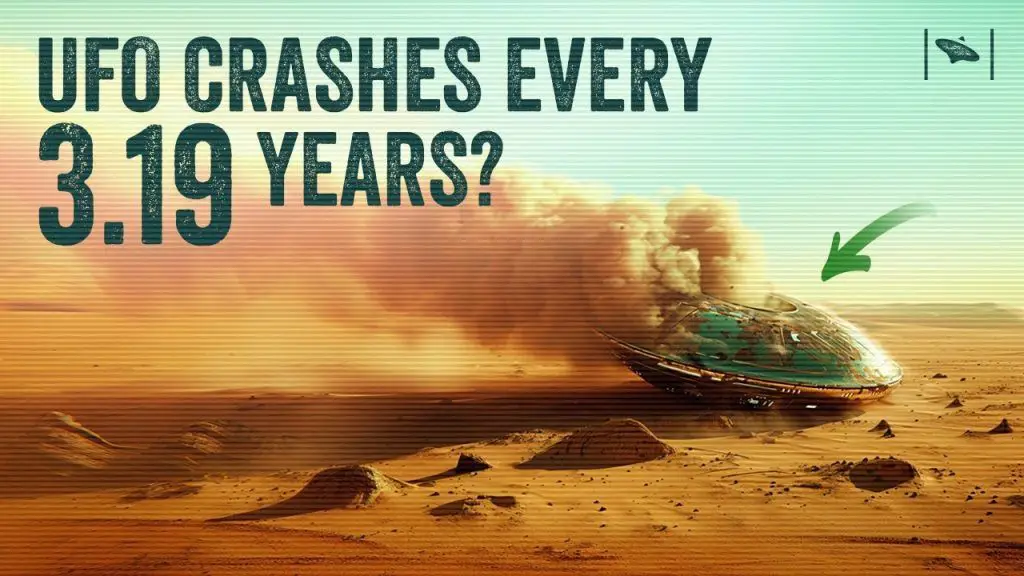
Welcome back, UFO enthusiasts! 
The Origin of the Theory
The idea of a 3.19-year UFO crash cycle originates from Joseph Ritrovato, who proposed this theory in his article “A Cyclic Period that Correlates with Alleged UFO Crash Retrievals.” Ritrovato observed that many reported UFO crashes seemed to occur in a repeating pattern approximately every 3.19 years. This pattern intrigued him, leading to a detailed analysis of historical UFO crash data.
Key Incidents Supporting the Cycle
One of the most notable UFO crashes, the Roswell incident, took place in July 1947. However, this was not an isolated event. Over the years, numerous other crashes have been reported, many of which align with the proposed 3.19-year cycle. For instance, the Varginha incident in Brazil in January 1996, often dubbed Brazil’s Roswell, involved the capture of alleged extraterrestrial beings and fits perfectly into the cycle.
Further supporting incidents include:
- June 1884, Benkelman, Nebraska: Witnesses observed a cigar-shaped object crash, leaving mechanical fragments.
- April 1897, Aurora, Texas: A mysterious airship crashed into a windmill, reportedly killing its non-human pilot.
- March 1948, Aztec, New Mexico: Less than a year after Roswell, another crash occurred, with the military swiftly intervening, similar to Roswell.
- September 1957, Ubatuba, Brazil: Fishermen witnessed a flying disk explode, leaving behind pure magnesium fragments.
- October 1967, Shag Harbor, Nova Scotia: A UFO was seen crashing into the harbor, with lights visible underwater.
Planetary Cycles and UFO Crashes
Ritrovato theorizes that there might be a connection between these UFO crashes and planetary cycles, particularly Mars’ orbit, which is approximately 776 days (a little over 2 years). It has been suggested that the Mars cycle can affect plate tectonics on Earth, raising questions about the possible influence of planetary positions on UFO activities.
Interestingly, some crash dates coincide with Mars’s closest approaches to Earth. For example, crashes on November 3, 1958, and October 17, 1973, occurred on the same day as Mars’s closest approach, suggesting a potential correlation.
Statistical Analysis and Findings
To further investigate this theory, a detailed analysis was conducted, considering various cycles, including Mars (2.1 years), Jupiter (11.86 years), and Saturn (29.5 years). The analysis revealed:
- Mars cycle: Multiple pairs of years showed a 2.1-year cycle alignment, suggesting potential correlation, although not consistent enough to establish a definitive pattern.
- Jupiter cycle: Only one pair of years showed alignment, insufficient to indicate a strong correlation.
- Saturn cycle: Several pairs of years showed a 29.5-year cycle alignment, indicating potential influence.
These findings suggest that planetary cycles, particularly those of Mars and Saturn, might influence the timing of significant UFO events. However, a larger data set and more precise timing of incidents are needed for more definitive conclusions.
Future Predictions
Based on the 3.19-year cycle, Ritrovato predicted future peak dates for UFO crashes. Notable predictions include April 24, 1999, and September 9, 2005. While some of these predictions align with reported UFO activities, the theory requires further investigation and validation.
VIDEO: Chris Lehto – Uncovering the 3.19 Year UFO Crash Cycle: Evidence & Theories
Joseph Ritrovato’s research presents a compelling case for a cyclic pattern in UFO crash retrievals. While further investigation is necessary, the evidence suggests a potential link between planetary cycles and UFO activities. This theory opens up new avenues for understanding UFO phenomena and encourages further research and data collection.
As we look to the future, could we anticipate significant UFO events based on these cycles? By studying past data and predicting future patterns, we might be better prepared to investigate and understand these mysterious occurrences.
Thank you for joining us on this exploration of the 3.19-year UFO crash cycle. Please like and subscribe for more intriguing content. If you have any insights or data to share, join the discussion on the UAP Society Discord. Until next time, keep watching the skies!


Leave a Reply